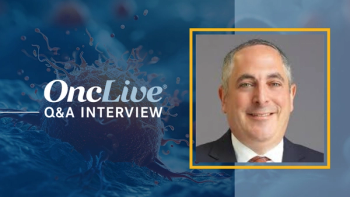
Role of Targeted Therapies Evolving in CLL
The treatment landscape for patients with chronic lymphocytic leukemia continues to evolve, as long-term data become available from pivotal studies that led to the FDA approvals for the BTK inhibitor ibrutinib (Imbruvica) and the PI3K inhibitor idelalisib (Zydelig).
Jennifer Brown, MD, PhD
The treatment landscape for patients with chronic lymphocytic leukemia (CLL) continues to evolve, as long-term data become available from pivotal studies that led to the FDA approvals for the BTK inhibitor ibrutinib (Imbruvica) and the PI3K inhibitor idelalisib (Zydelig), according to a presentation by Jennifer Brown, MD, PhD, at the 2016 ASCO Annual Meeting.
For BTK inhibition, follow-up data have identified distinct groups of patients who benefit the most from ibrutinib. These data have shown that patients with del17p CLL respond but still remain at high risk of progression; furthermore, those who progress on ibrutinib have limited options and poor outcomes.
Ibrutinib Standard of Care
While the efficacy data for PI3K inhibitors is promising, these agents have been fraught with toxicity concerns, specifically in the frontline setting when used in combination. Newer agents are in development and clinical studies continue to assess the optimal use of these therapies.The longest follow-up data for ibrutinib is available from the pivotal PCYC-1102-CA study, which led to an accelerated approval for ibrutinib in CLL. In this study, treatment-naive patients (n = 31) had an objective response rate (ORR) with ibrutinib of 84%, which included a complete remission (CR) rate of 23%. For those with relapsed/refractory disease, the ORR reached 90%, with a CR rate of 7%.
The 30-month progression-free survival (PFS) rate with ibrutinib in those without del17p/11q was 87%. In the del11q group, the 30-month PFS rate was 74.2%. In those with del17p CLL, the 30-month PFS rate was 45.9% and the median PFS was 28.1 months. Median PFS was not yet reached in the other 2 groups.
"The progression-free survival in those with low-risk disease is 87% at 2 and a half years, so really quite excellent in a patient population with a median of 4 prior therapies," said Brown, from the Dana-Farber Cancer Institute. "For the 11q patients, this declines to 74%—still quite excellent—but for the 17p patients there's a continuous drop-off, and they have reached a median PFS of a little more than 2 years. These patients are still at high risk for relapse."
At this point, those who progress on ibrutinib typically have poor outcomes. In available data, median overall survival (OS) in those with progressive CLL is 17 months and patients who experience Richter's transformation (n = 18) have a median OS of 3.5 months.
"If you do have a patient actively progressing on ibrutinib, you don't want to stop ibrutinib until you have another plan clearly in place, because sometimes these patients will develop quite explosive disease flare that one can lose control of quite quickly," said Brown. "I generally maintain the ibrutinib until the next therapy is selected and ready to go."
In addition to progression, 10% to 30% of patients will discontinue ibrutinib due to adverse events (AEs). Stopping treatment due to AEs is more common seen in older patients, such as those between the ages of 70 and 80. The most common causes for discontinuation are diarrhea, fatigue, arthralgia, and muscle spasm, which are mostly low-grade events that can be managed. Other reasons include atrial fibrillation and bleeding-related events.
"In terms of managing the bleeding, there is expanding anecdotal experience with anticoagulation with ibrutinib but it is still fairly limited, so we try to avoid it. There is similarly limited data with antiplatelet agents," said Brown. "For now, we hold ibrutinib 3 to 7 days prior to or post surgery, or for anything with stitches."
In the more recent RESONATE-2 trial, the 18-month PFS rate with ibrutinib in the frontline setting was 90% versus 52% with chlorambucil. The 24-month OS rate was 98% with ibrutinib versus 85% with chlorambucil. There were 3 deaths in the ibrutinib arm versus 17 deaths with chlorambucil.
In terms of AEs in the ibrutinib arm, 14% of patients experienced hypertension and 6% had atrial fibrillation. Furthermore, a major hemorrhage was experienced by 4% of patients and 2 had sudden deaths.
"This study has short follow-up still, and chlorambucil is a poor comparator—not a standard of care anymore," said Brown. "The patients were low risk and had quite low comorbidity for their age. Toxicity was not negligible, and therapy is planned indefinitely, so over time we expect to see problems with compliance that can lead to an increased risk for resistance."
Other studies are looking at ibrutinib in comparison with standard of care options in the frontline setting, Brown noted. A phase III study is looking at ibrutinib plus rituximab compared with fludarabine, cyclophosphamide, and rituximab.
Second-Generation BTK Inhibitors
"The data with the rituximab combination or bendamustine-rituximab combinations don't appear to show a marked PFS difference compared with single-agent ibrutinib, although there is an update suggesting that the complete remission rate is increasing, which could translate to improvements in overall survival," said Brown.Ibrutinib hits a number of kinases in addition to BTK, including EGFR, ITK, and TEC, which are thought to mediate some of the AEs seen with the TKI. Second-generation BTK inhibitors are being developed that hit fewer targets, noted Brown. Chief among these emerging options is acalabrutinib (ACP196), which does not bind to EGFR, ITK, and TEC at the same level as ibrutinib.
At 14.3 months of follow-up, the ORR with acalabrutinib was 95%, which consisted of all partial responses (PRs) or PRs with lymphocytosis. There was 1 death due to pneumonia and 1 from progressive disease. There is some bleeding with this agent, although this event is less frequent compared with ibrutinib, Brown noted.
Utility of Idelalisib Limited by Toxicity
The next-generation BTK inhibitor BGB-3111 similarly does not target EGFR and ITK but still has an affinity for TEC. In early response data in CLL from 14 patients, the ORR with BGB-3111 was 93%, which consisted of all PRs. "This has the expected pattern of a highly effective BTK inhibitor," Brown noted.The delta isoform-specific PI3K inhibitor idelalisib is approved as a treatment for patients with CLL who are candidates for treatment with rituximab. This approval was based on findings from the 116 study, in which idelalisib plus rituximab showed a median PFS of 19.4 months compared with 7.3 months with placebo plus rituximab. In a separate study, known as 115, the combination of idelalisib plus bendamustine and rituximab (BR) showed a median PFS of 23.1 months compared with 11.1 months for BR alone.
In the frontline setting of patients aged ≥65 years, idelalisib plus rituximab had an ORR of 97%, with a CR rate of 19%. The PFS rate was 83% at 36 months. In those with del17p CLL (n = 9), the ORR was 100% and the CR rate was 33%.
However, this study demonstrated significant toxicity, noted Brown. Diarrhea of any grade occurred in 64% of patients, 42% of which was grade ≥3. Additionally, grade ≥3 pneumonia was seen in 19% of patients and transaminase elevation occurred in 23% of patients.
"These adverse events were most common in those receiving their frontline therapy," said Brown. "In fact, we've recently completed an investigator initiated study in untreated patients of any age where we had a 52% incidence of grade 3/4 transaminitis associated with an activated CD8+ infiltrate in the liver."
Age is a critical risk factor for hepatotoxicity with idelalisib, with incidence more common in younger patients. In the investigator-initiated study, all patients under the age of 65 required systemic steroids to treat early hepatotoxicity. Over time, treatment with idelalisib led to a decrease in Tregs, specifically in those who experienced toxicity, suggesting a connection between the AE and the immune system, noted Brown.
"In terms of managing these immune-related adverse events, it is important to be vigilant. The risk is likely higher in less heavily pretreated and younger patients," said Brown. "There's a need to hold the drug early, evaluate completely for infection, and treat. This may provoke the immune-related toxicity, however, so one needs to start steroids if you have a drug-related toxicity."
In March 2016, six clinical trials exploring idelalisib in combination with other therapies were halted due to reports of an increased rate of AEs, including death. This halt was primarily related to a small increase in deaths with idelalisib in 3 randomized trials exploring earlier treatment, noted Brown. Two of these studies were looking at idelalisib with bendamustine.
Other PI3K Inhibitors in Development
"Most deaths were related to bacterial infection, neutropenia, and sepsis. They suggest some synergy with BR in that regard. There were a few opportunistic infections," said Brown. However, these events were not new, and had been observed in prior studies exploring the agent, she observed. "Idelalisib should not be used in the upfront setting. It should be used after ibrutinib, but anecdotal data suggests it should work in that setting."The PI3K gamma and delta inhibitor duvelisib (IPI-145) is currently in development for patients with CLL. Inhibiting the gamma isoform should impact T cells in the microenvironment, which could modulate the immune toxicity associated with PI3K delta inhibition, Brown noted.
In a phase I study for patients with CLL, duvelisib showed an ORR of 83%, when including nodal responses. The median PFS was not yet reached, with a 24-month PFS rate of 59%. The open-label phase III DUO study is comparing single-agent duvelisib with ofatumumab in 300 patients with relapsed/refractory CLL.
In mid-June, treatment with single-agent duvelisib demonstrated an ORR of 46% for patients with indolent non-Hodgkin lymphoma, which successfully met the primary endpoint for the phase II DYNAMO study but not investor expectations, according to the developer of the PI3K-delta and -gamma inhibitor, Infinity Pharmaceuticals.
This set off a cascade of events, including a restructuring of the company. Additionally, Abbvie, which was codeveloping the agent, returned all rights to Infinity. Despite this, the company continues as planned for the CLL trial.
The second PI3K inhibitor in development is TGR-1202, which has been labeled a next-generation agent, since it was developed specifically to avoid the occurrence of transaminitis, Brown said. The median PFS with TGR-1202 in CLL was 24 months.
In early data, the diarrhea/colitis rates were lower with TGR-1202 compared with other PI3K inhibitors, she noted. In a phase I study, just 1% of patients experienced grade 3/4 diarrhea/colitis, and the rates of ALT/AST elevations and discontinuation due to AEs were 2% and 4%, respectively.
"The mechanism for this is not clear, since some of these immune toxicities do appear to be on target effects of delta inhibition. It's unclear if there is less delta inhibition or perhaps there's another target that is mitigating the effect," said Brown. "We clearly need more science understanding the impact of the various PI3 kinase inhibitors on the immune system in order to optimize our use of these drugs going forward."
A number of clinical trials continue to assess both PI3K inhibitors and BTK inhibitors for patients with CLL and other hematologic malignancies. Additionally, these agents are being explored in other settings and for patients with solid tumors. The CLL treatment landscape is likely to continue to evolve as reports from these studies become available.
Brown JR. Targeted Therapy in Chronic Lymphocytic Leukemia: Where are we now? Presented at: 2016 ASCO Annual Meeting; Chicago, Illinois; June 3-7, 2016.

























































































